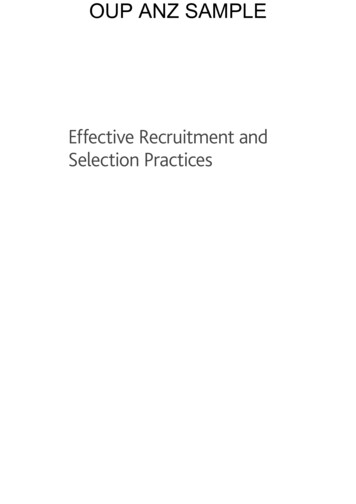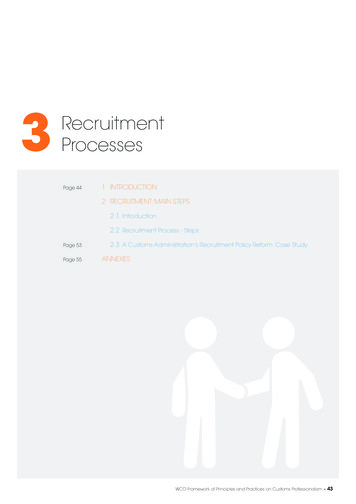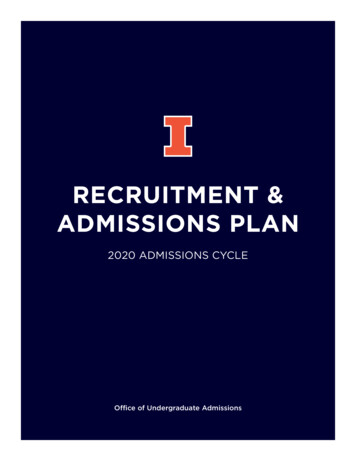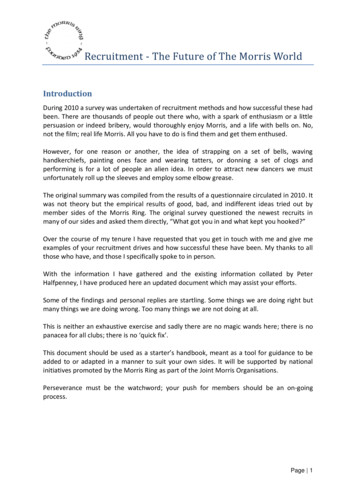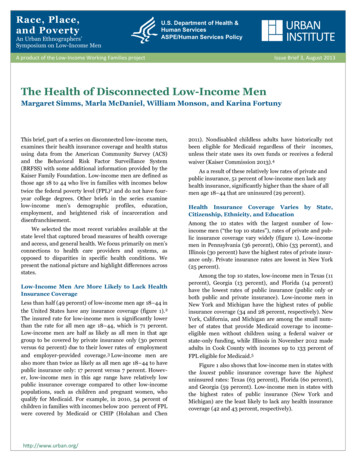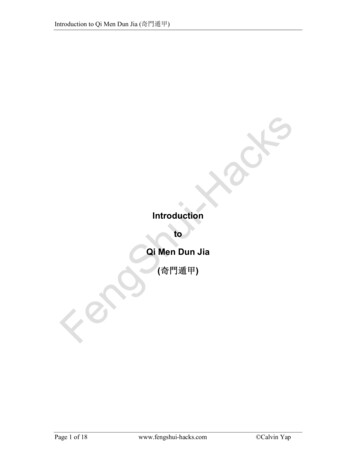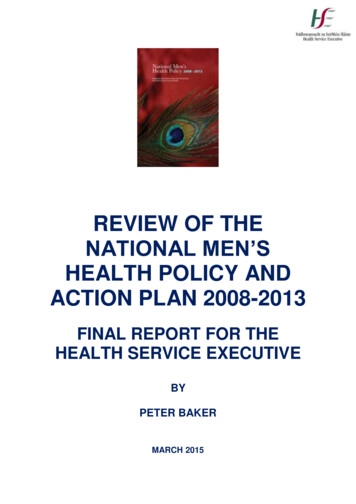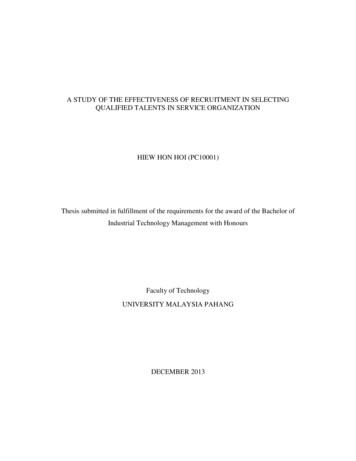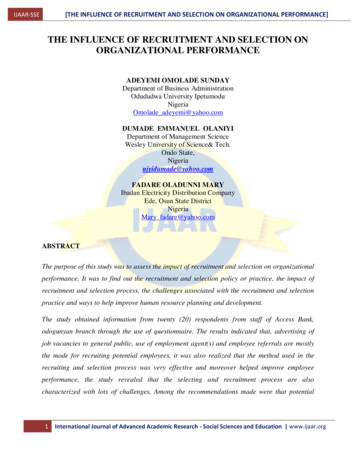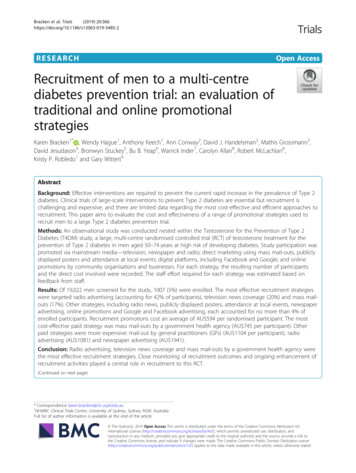
Transcription
Bracken et al. Trials(2019) EARCHOpen AccessRecruitment of men to a multi-centrediabetes prevention trial: an evaluation oftraditional and online promotionalstrategiesKaren Bracken1* , Wendy Hague1, Anthony Keech1, Ann Conway2, David J. Handelsman2, Mathis Grossmann3,David Jesudason4, Bronwyn Stuckey5, Bu B. Yeap6, Warrick Inder7, Carolyn Allan8, Robert McLachlan8,Kristy P. Robledo1 and Gary Wittert9AbstractBackground: Effective interventions are required to prevent the current rapid increase in the prevalence of Type 2diabetes. Clinical trials of large-scale interventions to prevent Type 2 diabetes are essential but recruitment ischallenging and expensive, and there are limited data regarding the most cost-effective and efficient approaches torecruitment. This paper aims to evaluate the cost and effectiveness of a range of promotional strategies used torecruit men to a large Type 2 diabetes prevention trial.Methods: An observational study was conducted nested within the Testosterone for the Prevention of Type 2Diabetes (T4DM) study, a large, multi-centre randomised controlled trial (RCT) of testosterone treatment for theprevention of Type 2 diabetes in men aged 50–74 years at high risk of developing diabetes. Study participation waspromoted via mainstream media—television, newspaper and radio; direct marketing using mass mail-outs, publiclydisplayed posters and attendance at local events; digital platforms, including Facebook and Google; and onlinepromotions by community organisations and businesses. For each strategy, the resulting number of participantsand the direct cost involved were recorded. The staff effort required for each strategy was estimated based onfeedback from staff.Results: Of 19,022 men screened for the study, 1007 (5%) were enrolled. The most effective recruitment strategieswere targeted radio advertising (accounting for 42% of participants), television news coverage (20%) and mass mailouts (17%). Other strategies, including radio news, publicly displayed posters, attendance at local events, newspaperadvertising, online promotions and Google and Facebook advertising, each accounted for no more than 4% ofenrolled participants. Recruitment promotions cost an average of AU 594 per randomised participant. The mostcost-effective paid strategy was mass mail-outs by a government health agency (AU 745 per participant). Otherpaid strategies were more expensive: mail-out by general practitioners (GPs) (AU 1104 per participant), radioadvertising (AU 1081) and newspaper advertising (AU 1941).Conclusion: Radio advertising, television news coverage and mass mail-outs by a government health agency werethe most effective recruitment strategies. Close monitoring of recruitment outcomes and ongoing enhancement ofrecruitment activities played a central role in recruitment to this RCT.(Continued on next page)* Correspondence: karen.bracken@ctc.usyd.edu.au1NHMRC Clinical Trials Centre, University of Sydney, Sydney, NSW, AustraliaFull list of author information is available at the end of the article The Author(s). 2019 Open Access This article is distributed under the terms of the Creative Commons Attribution 4.0International License (http://creativecommons.org/licenses/by/4.0/), which permits unrestricted use, distribution, andreproduction in any medium, provided you give appropriate credit to the original author(s) and the source, provide a link tothe Creative Commons license, and indicate if changes were made. The Creative Commons Public Domain Dedication o/1.0/) applies to the data made available in this article, unless otherwise stated.
Bracken et al. Trials(2019) 20:366Page 2 of 14(Continued from previous page)Trial registration: ANZCTR, ID: ACTRN12612000287831. Registered on 12 March 2012.Keywords: Participant recruitment, Recruitment strategies, Men’s health, Randomised controlled trials, Diabetesprevention, Advertising, Social media,BackgroundWorldwide, an estimated 1 in 11 adults has diabetes,and Type 2 diabetes accounts for 90% of these cases [1].Research to identify effective interventions to preventdiabetes is urgently needed to address this global problem. However, recruitment to disease prevention trials,including diabetes prevention trials, can be challenging.Firstly, since participants in disease prevention trialstend to be healthy and asymptomatic, clinicians may notbe able to identify eligible patients through their clinics[2]. Secondly, potential participants may not perceivebenefit in participating in disease prevention research,particularly if they do not believe that they are at risk ofthe disease [3, 4]. Lack of perceived benefit may contribute to lower rates of consent, requiring larger numbersof people to be screened [5]. Thirdly, screening numbersmust be large in prevention trials if a modest effect sizeis hypothesised to ensure adequate power.To overcome the challenge of recruiting sufficientnumbers of participants, previous diabetes preventiontrials have reported promoting study participationthrough: media coverage [6–9], advertising [7–11], massmailings [7, 9, 12], referrals from physicians or clinics [6,7, 9, 10, 12], community-based initiatives [6, 7, 10, 12,13] and public screening events [7–9, 12]. Evaluations ofthese same recruitment strategies have also been reported in other research areas, including lifestyle improvement interventions [14], smoking cessation [15]and treatment of benign prostatic hyperplasia [16, 17].While the existing literature provides useful recruitmentguidance, papers have often lacked sufficient detail onhow strategies were implemented and delivered, andhow much they cost [18], making replication difficult[19]. Evaluations of approaches to promote randomisedcontrolled trial (RCT) participation to members of thepublic is an area of research need, identified as one ofthe top ten areas for recruitment methodology researchin a recent priority-setting study [20].Recently, online recruitment through Facebook andGoogle advertising has been reported to be both affordable and effective in recruiting participants to survey research [21] and trials of short duration involving webbased interventions [22, 23]. Online advertising hassome advantages over more traditional promotionalstrategies as it is faster to implement, easier to monitor,has lower start-up costs and can potentially reach largernumbers of people quickly [24]. However, to date, mostevaluations of online strategies to recruit to RCTs havefocussed on recruiting younger people [24–26]. Furthermore, evidence on the effectiveness of online strategiesin the recruitment of men is mixed. Two studies foundonline promotions less effective in recruiting men compared to women [27, 28], but one found no significantdifference in gender balance between online and traditional approaches [24]. More evidence is needed to assess whether online recruitment strategies are effectivein recruiting middle-aged and older men to RCTs [29].The aim of this study was to describe and evaluate thestrategies used to promote recruitment to the T4DMdiabetes prevention RCT.MethodsSettingThis observational study of recruitment strategies wasset within the Testosterone for the Prevention of Type 2Diabetes (T4DM) trial (ACTRN12612000287831). Thedesign of the T4DM trial has been published separately[30]. Briefly, T4DM is a large, multi-centre, phase-III,double-blind, placebo-controlled, 2-year trial of testosterone therapy combined with a lifestyle intervention(Weight Watchers ) compared to the lifestyle intervention alone for the prevention of Type 2 diabetes. Thetrial is running through six centres in Australian capitalcities and recruitment occurred from January 2013 toFebruary 2017. The trial enrolled men aged 50–74 yearswho were overweight or obese ( 95 cm waist circumference), had pre-diabetes or newly diagnosed Type 2 diabetes, and testosterone level 14.0 nmol/L. The trial isongoing and follow-up is due to be completed in May2019.The T4DM trial design presented a number of recruitment challenges. Firstly, very few participants could bereferred to the study by investigators at the participatingcentres since prospective participants were unlikely tobe under the care of an endocrinologist. We thereforeplanned to seek prospective participants directly fromthe community, predicting that only one in four menscreened in this non-targeted way would be eligiblebased on the entry criteria of elevated blood glucose andlow serum testosterone. Secondly, we predicted that theplacebo-controlled and injectable nature of the studytreatment, as well as its 2-year duration, might limit thenumber of men willing to participate. Taking these twofactors into account, we estimated that approximately
Bracken et al. Trials(2019) 20:366Page 3 of 1420,000 men would need to be screened in order to reachthe final recruitment target of 1000 participants.Table 1 Recruitment plan formulationPlanningconsiderationsDetailsScreening and enrolment processTarget audienceMen aged 50–74 years who were overweight orobese and living in a capital city with aparticipating study centre. No further restrictionswere placed as other eligibility criteria were tobe assessed during the screening processCall to actionProspective participants were invited to visitstudy website or call a central information lineto learn more about the study and completethe pre-screening questionnaireContent ofpromotional materialContent decisions were guided by qualitativeresearch in men’s health communicationpreferences [32], pro-bono advice from marketing professionals, and pre-testing and ongoingfeedback from study participantsCommunication style: Frank, humorous and empathetic message [32] Simple, informal and easy-to-rememberlanguageKey components of the message:1. Identification of the problem: men aged 50–74 years and overweight/obese are at risk ofdiabetes, weight gain and urinary and sexualproblems2. Positioning of the study as a solution: theTestosterone for the Prevention of Type 2Diabetes (T4DM) study can support men to loseexcess weight and address related health issues3. Call to action: invitation to join the study andinstructions on how to joinPromotionalstrategies/platformsPromising promotional strategies were identifiedby review of the published literature, discussionwith the study’s industry partners, brainstormingby the Steering Committee, suggestions fromstudy participants and pro-bono advice frommarketing professionals.Strategies were first tested for a short period oftime, and if they appeared effective andaffordable, were adopted on an ongoing basis.Men who heard about the study through the promotional strategies to be described in this paper were invited to complete a pre-screening questionnaire online(on the T4DM study website, www.diabetesprevention.org.au), or over the telephone (by calling the central coordinating centre). Men who were eligible on the prescreening questionnaire were emailed or posted a prescreening patient information and consent form, instructions and a request form to attend for screening bloodtests to be conducted at one of a large number ofcontracted pathology collection centres from one national commercial pathology provider company. Participants who were eligible on the screening blood testswere then contacted by their preferred centre to arrangea screening clinic visit. Eligible and consenting participants were enrolled and randomised at the clinic.Recruitment oversight and planningDuring the recruitment phase, the Steering Committeemet monthly by telephone to oversee the recruitmentplan and monitor the ongoing performance of recruitment strategies. The Human Review Ethics Committeesapproved the study’s recruitment strategies and promotional material. Where promotional activities involvedreal-time communication with the public; for example,through Facebook posts, the approach to be taken withthese communications, and the subject matter to be covered, received ethical review and approval.Development of the recruitment plan involved fourkey considerations based on marketing principles [31]:selection of the target audience, definition of the call toaction, design of the promotional material and selectionof promotional strategies to be used (Table 1).Recruitment strategiesRecruitment strategies were coordinated centrally by thestudy project manager (KB). In general, nationwide strategies were implemented by staff at the central coordinating centre, while local and community strategies wereimplemented by site study nurses and investigators. Eachstrategy is described in turn below. Strategy descriptionswere guided by the Template for Intervention Description and Replication (TIDieR) Checklist, which lists theitems to be reported when describing interventions tosupport replication [19].Radio advertisingRadio advertising involved 30-second paid advertisementson 20 different radio stations (nine talkback stations and11 music stations). Three different scripts were recordedover the course of the study in order to keep the messagefresh (see Additional file 1). Advertisements ran fromJanuary 2014 to July 2016, but were not run continuouslyon all stations over this period. Instead, advertisementsran in campaigns of 3–4 weeks’ duration, with stationsrunning between one and seven campaigns over thecourse of study recruitment. In total 68 campaigns wererun, 45 on talkback stations and 23 on music stations, andadvertisements were played in a total of 7110 paid spots.In addition to paid spots, stations offered bonus fillerspots free of charge. In some cases these were more frequent than the paid spots and so the total number oftimes that study radio advertisements were run is likely tobe in the range of 10,000–15,000 times.In Australia, radio stations are generally broadcastwithin a single state so advertisements were booked separately for each of the five states where the study siteswere located. Radio stations were selected based on advertising costs and listener demographics. To inform selection of advertising times, we sourced listener
Bracken et al. Trials(2019) 20:366demographics (including age and gender) by time of dayfor each radio station. Generally, men aged 50 to 74years were most likely to listen in the early morningsand late afternoons on weekdays, although these werealso the most expensive times to advertise. A single campaign was booked on selected stations and the numberof participants screened and enrolled, as well as the costper participant screened and enrolled, were measured.Campaigns on stations with a cost of less than AU 50per participant screened were generally repeated. Modifications were made to the time of day that advertisingwas played based on the performance of previous campaigns and on advice from radio station advertisingpersonnel.Mail-outsMass mail-outs involved posting a study invitation package to men on the Medicare database by the AustralianGovernment Department of Human Services (DHS).The Medicare database, the infrastructure underpinningthe national health scheme, includes Australian residentswho are eligible for public healthcare, generally thosewho are Australian or New Zealand citizens, or havepermanent Australian residency status. Mailings wereconducted in July 2016 (40,000 invitations sent), September 2016 (60,000 invitations sent) and November2016 (30,000 invitations sent), with 130,000 men in totalbeing mailed once each. Mailing recipients were randomly selected from the Medicare database based on being male, aged 50–74 years and living within closeproximity of one of the study sites (the initial mailing included a sample of men living within a 20-km radius ofa study site and the subsequent mailings were further restricted to men living within 5–10 km of a study site).Men who had been prescribed testosterone or antidiabetic therapies within the previous 12 months wereexcluded from the mailing list by linking to the Pharmaceutical Benefits Scheme database. The invitation package consisted of a cover letter from the DHS, aninvitation letter from the study Chair and a study postcard (see Additional file 1). The mailing was conductedby a third party mailing house contracted by the DHS.The contact details of mailing recipients were kept confidential and were not shared with the study coordinating centre.In addition, a one-time mail-out by a single networkof general practices (GPs) to a targeted group of theirpatients was conducted from February to March 2013 inone city. Though the number of letters sent in this GPmail-out was not recorded it is estimated to be less than500 letters.It is possible but unlikely that men who received a letter in the GP mail-out in early 2013 also later received aletter from the DHS in 2016. The responses to the smallPage 4 of 14GP mail-out and the later and much larger DHS mailout were recorded and reported separately.Television, radio and newspaper news coverageIn the period January 2013 to June 2016, approximately15 press releases and approaches to media were made.The study chose not to engage a public relations firmdue to cost concerns. Instead, press releases were facilitated by site investigators and prepared by Universityand Hospital media offices and were distributed to local,state and national television, radio and newspaper newsorganisations. Press releases highlighted newsworthy aspects of the study and provided quotes from study investigators and study participants. Media office contactdetails were provided so that journalists could arrangeinterviews with investigators and participants. Over therecruitment period, nine newspaper stories, eight television stories and seven radio news stories were broadcast.Facebook promotions and advertisingThe study Facebook page was set up by the central coordinating centre in May 2013. Over the period May2013 to December 2016, 94 stories were posted to thestudy Facebook page. Stories covered a mixture of topicsincluding information about the study and how to join,links to news stories about the study, men’s health information and general interest stories. In addition, 23 advertising campaigns and paid boosted posts were runintermittently in the period October 2013 to December2016 (see Additional file 2 for definitions of commonFacebook advertising terms). Advertisements focussedon inviting men to join the study. By contrast, boostedstories tended to promote news stories relating to theT4DM study. Advertisements and paid boosted storiestargeted men aged 50 years or older living in a capitalcity with a T4DM study site. Examples of advertisementsand posts can be found in Additional file 1. The Facebook Ads Manager application allowed advertising performance to be monitored in real time by reporting thenumber of impressions, number of clicks, cost per clickand cost per 1000 impressions of each campaign. Whilepaid campaigns were running, the coordinating centrereviewed performance statistics daily and increased ordecreased the advertising spend according to the successof the advertisement. Comments from participants andfrom the public were used to refine Facebook page content over time.Indirect Facebook promotions were also used. Whenparticipants completed the online screening questionnaire they were invited to share information about thestudy on their Facebook page. Local organisations andbusinesses, such as sporting clubs, social clubs andhealthcare providers, were also approached to share information about the study on their own Facebook pages.
Bracken et al. Trials(2019) 20:366We were unable to determine how many people and organisations shared information about the study on theirFacebook pages.Google advertisingPaid Google advertising was set up by the central coordinating centre using the Google AdWords application(see Additional file 2 for definitions of common Googleadvertising terms). The purpose of these advertisementswas to display a link to the study website at the top ofthe Google search results screen when members of thepublic googled terms which indicated that they might beinterested in joining the study. We identified four possible Google search themes: diabetes prevention, low testosterone, weight loss and nocturia (night-timeurination). However, after further investigation the lowtestosterone theme was rejected due to Google advertising rules and the weight-loss theme was rejected due tothe high levels of competition and hence high cost. Forthe two remaining themes (diabetes prevention and nocturia), Google AdWords provided a list of the most commonly used related search terms, known as keywords,which we used to build our advertising campaigns (seeAdditional file 1). Advertising ran from July 2013 to October 2014 and October to December 2015. All advertisements were targeted to users within Australia only.Later in the recruitment period, additional Google advertisements were run to ensure that people whosearched for the T4DM study name were able to locatethe website easily. Since the purpose of these advertisements was to facilitate screening of potential participantswho already knew about the study rather than to promote the study to the public, these advertisements andtheir associated costs have not been included in thispaper.Newspaper advertisingIn December 2013, one paid advertisement was placedin a Sunday newspaper with a circulation of 250,000 inone capital city. If effective, we planned to roll out newspaper advertising to other cities.Community outreach activitiesThroughout the recruitment period, site staff, and to alesser extent, central coordinating centre staff, conducted a range of community outreach activities. Theseincluded: (1) displaying posters in local businesses, organisations, libraries and hospitals; (2) attendance at localcommunity and health service events and (3) approaching local businesses and organisations to promotethe study to their customers, members and employees.Organisations who agreed to support the study includedmen’s community and recreational groups, privateschool old boys’ associations, private health insurancePage 5 of 14companies, trade unions, government workplaces, diabetes groups and Weight Watchers . These organisations supported the study through a variety of meansincluding placing information about the study in theirprint newsletters, email newsletters, on their websites,on Facebook pages and on notice boards. The majorityof community outreach activities occurred in the firstyear of study recruitment (2013), but continued sporadically throughout recruitment.In addition to these unpaid promotions, one paid promotion through a professional football club based nearone study site was trialled for 1 week in June 2016. Thestudy was featured in the club’s weekly email newsletterto its 9300 members as well as in banner and gutter adson the club’s website.Healthcare provider referrals and promotionsThroughout the recruitment period we approached localgeneral practitioners (GPs) and pathology collection centres to support study recruitment. The central coordinating centre wrote to 1024 GPs in the areas surroundingstudy sites to ask them to refer suitable patients to thestudy and to display a study poster in their waiting roomareas. Site staff also attended local GP meetings to inform them about the study. We asked pathology companies to display posters in their waiting rooms and toprint information about the study on the bottom of thereports of men who might be eligible for the study basedon their blood test results.Recruitment strategy monitoring and enhancementThe recruitment management process involved repeatedcycles of strategy implementation, monitoring and enhancement. The number of participants enrolled as a result of each strategy, the direct costs and the staff effortinvolved were monitored in real time and reported tothe Steering Committee on a monthly basis. The Committee identified the number of participants enrolled asthe primary means for assessing strategy effectivenessbut also considered cost-effectiveness, staff effort, potential to reach large numbers of men or to be targeted tomen who were most likely to be eligible.Outcomes and data analysisStrategy attributesAttributes which were thought to impact recruitment results were described for each strategy: content format(text, image, audio, audio-visual), content length (short,medium, long), approach to prospective participants(direct, indirect), level of targeting (ability to reachmembers of the public who were most likely to be eligible for the study in terms of age, location and health),potential reach (the number of people who would see
Bracken et al. Trials(2019) 20:366the strategy), frequency of exposure, and whether or notthe strategy included an online component.Strategy exposure and contributionWhere possible, we recorded the number of people exposed to each strategy. In addition, all men completingthe pre-screening questionnaire were asked to reporthow they heard about the study. This information waslinked to the participant’s screening and enrolment status by a unique participant identifier to estimate thecontribution of the strategy (the percentage of allscreened and randomised participants contributed byeach strategy) and to estimate how many participantsheard about the study through online and traditionalsources.Strategy costThe direct cost of implementing each recruitment strategy was recorded. The direct cost did not include staffing costs or the cost of conducting screening andenrolment activities. Costs were recorded in Australiandollars and were adjusted for inflation using the Australian Consumer Price Index [33]. All costs in this paperare expressed in June 2018 terms.We determined that measuring the indirect cost ofeach strategy would not be feasible. Instead, we collecteddetailed feedback from recruitment staff (at the centralcoordinating centre and at study sites) in order to estimate the staff effort involved in implementing eachstrategy (categorised as low, moderate or high per participant enrolled).Overall strategy appraisalFor each strategy, the number of participants randomised, the direct cost per participant, and the staff effortper participant were estimated and each scored 0 (lowest) to 3 (highest). Since the number of participants randomised was identified as the most important outcome,this was the primary means of assessing the effectivenessof each strategy (highly effective, effective, moderatelyeffective, limited effectiveness, ineffective). However, thedirect cost per enrolment, level of staff effort requiredper enrolment, and the strategy’s attributes were alsoconsidered to come to a final subjective appraisal of eachstrategy.Page 6 of 14ResultsOverall study recruitmentDuring the recruitment period (January 2013 to February 2017) 19,022 men were screened and 1007 were randomised to the T4DM trial. The number of menscreened per month fluctuated over the recruitmentperiod (Fig. 1), most likely influenced by the mix of promotional activities occurring at the time. Spikes in thenumber of men screened were observed when the trialwas featured in media news stories and when radio advertising campaigns and mass mail-outs were beingconducted.Evaluation of promotional activitiesNumber of participants recruitedTable 2 shows the number of men screened and randomised as a result of each promotional activity. Almost80% of participants heard of the study through one ofthree methods; radio advertising (42% of participants),television news coverage (20%) or mass mail-outs (17%).No other single strategy contributed more than 4% of allenrolments. Excluding strategies that resulted in fewerthan ten randomisations, the randomisation rate (percentage of screened participants who went on to be randomised) did not differ between strategies (p 0.31).The average randomisation rate was 5%.The response rate to the mass mail-out by the DHSwas 2.5% (3211 men screened from 130,000 letters sent);173 of these men went on to be randomised (0.1% of allmen mailed). It was not possible to calculate the response rate for other recruitment strategies; for example,radio advertising and news stories, since the denominator number of men exposed to these strategies wasunknown.Recruitment costA total of AU 598,633 was spent on promotional activities at an average cost of AU 31 per participantscreened and AU 594 per participant randomised. Thetotal direct cost and cost per participant for each strategy are shown in Table 3. The cost of individual strategies ranged from no cost (free media news coverageand word of mouth) to AU 312 per screened participantfor online promotion of the study by a football club. Ofthe paid strategies, mass mail-out by the DHS was themost cost-effective (AU 40 per screening and AU 745per randomisation).Statistical methodsData analysis was conducted in SAS v 9.4 (Cary, NC,USA). Simple descriptive statistics were used to describethe number of participants screened and randomised.Differences between groups in enrolment rates and inthe proportion aged 60 years or older were tested usingchi-square analyses with a significance level of 5%.Staff time and effortThe task of organising, conducting and monitoring promotional activities took an estimated average of 20person-hours per week over the 4-year recruitmentperiod. The work was divided between seven study teammembers (one project manager at the central
Bracken et al. Trials(2019) 20:366Page 7 of 14Fig. 1 Number of participants screened, and recruitment strategies conducted, by calendar monthcoordinating centre and six site-based study nurses) andfluctuated throughout the recruitment period. The staffeffort required for each strategy, proportional to thenumber of participants enrolled, is estimated in Table 4.In general, paid strategies, such as advertising and massmail-outs, required the least staff effort, while low-costand unpaid strategies,
more, evidence on the effectiveness of online strategies in the recruitment of men is mixed. Two studies found online promotions less effective in recruiting men com-pared to women [27, 28], but one found no significant . Radio advertising involved 30-second paid advertisements on 20 different radio stations (nine talkback stations and 11 .

